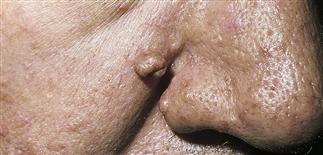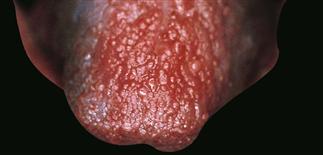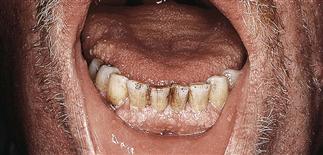159
Inherited cutaneous paraneoplastic syndromes

Various cutaneous lesions, such as cysts, fibrous tumors, and hair follicle tumors, may be associated with internal malignancy.

Large sebaceous gland tumors are yellowish umbilicated tumors that can be associated with colonic polyps in Muir–Torre syndrome.

Cowden syndrome. Multiple mucosa-colored papules on the tongue. From Bolognia JL, Jorizzo JL, Rapini RP, eds. Dermatology. London: Mosby; 2003.

Cowden syndrome (multiple hamartoma). Hamartoma of the skin and mucosa occurs in 90% of cases. Cobblestoning of the gingiva is a characteristic finding.
Inherited cutaneous paraneoplastic syndromes involve cutaneous findings associated with heritable or genetically related conditions that carry an increased risk of internal malignancy.
COWDEN SYNDROME
• Cowden syndrome, or multiple hamartoma syndrome, is a rare, under-diagnosed disorder affecting multiple organ systems. • Affected individuals develop benign and malignant tumors. • Breast cancer occurs in more than 30% of female patients. Thyroid carcinoma is also common. • Characteristic varieties of facial and oral papules develop during early adulthood. • Facial papules are 1–3 mm, smooth, skin-colored, and concentrated around eyes, nose, malar cheeks, and mouth. Biopsy usually confirms the papule as a trichilemmoma, which is characteristic of Cowden syndrome when multiple. • Oral mucosal papules are 1–3 mm, smooth, and white, coalescing into a cobblestone pattern on tongue and gingiva. • Punctate keratoses of palms and soles occur in roughly half of patients. • Female patients suspected of having Cowden syndrome should have regular breast examinations, mammograms, and very close follow-up. Prophylactic bilateral mastectomy has been suggested by some.
GARDNER SYNDROME
• An autosomal dominant condition consisting of multiple epidermal cysts and fibrous tumors of the skin and subcutaneous tissue, and associated intestinal polyposis. • Intestinal polyps are usually limited to the colon. • Malignant degeneration of polyps occurs in 50% of patients. • There is usually a family history of colon cancer. • Individuals develop multiple epidermal cysts, most commonly on face and scalp. • Discrete fibrous tumors of the skin are rarely symptomatic. • Multiple pilar cysts of the scalp are not associated with Gardner syndrome.
MUIR–TORRE SYNDROME
• An autosomal dominant condition with multiple, benign, cutaneous, sebaceous tumors and colonic polyps with increased risk of malignant degeneration. • Muir–Torre syndrome is suggested by the presence of multiple benign tumors of the sebaceous glands, including sebaceoma, sebaceous adenoma, and basal cell carcinoma with sebaceous differentiation. Of these, the most specific for Muir–Torre is the sebaceous adenoma. • Patients also develop keratoacanthomas with distinctive sebaceous differentiation. • Sebaceous hyperplasia is a common condition in otherwise healthy people, and is not considered part of the Muir–Torre syndrome. • Patients suspected of having Muir–Torre syndrome or Gardner syndrome should undergo colonoscopy.







